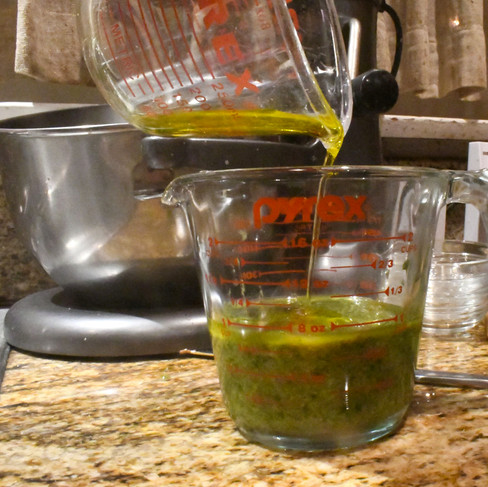Chef's Corner: Pesto alla Genovese
- Howie's Market & Alexander's Prime Meats

- Feb 24, 2023
- 4 min read

Pesto alla Genovese or just Pesto is a classic and extremely popular dish. With the advent of blenders and food processors the entire dish can be prepared in the time it takes to boil the pasta of your choice.
Modern conveniences can have disadvantages. In this case the speed of the whirring blades is quite different than the age-old method using a mortar and pestle. The word 'pesto' is derived from Genoese word, pestâ , or Italian, pestare, translating to "to pound", "to crush", which is exactly what you do with the mortar and pestle. Motarized methods tend to give pesto a slightly 'cooked' quality. We think the purely hand-made method is superior. You will be rewarded for your efforts. And, with practice, you still can have it done in the time it takes to boil the pasta.
The traditional mortar for this dish is from the Mediterranean and made of marble. The pestle is made of wood. We don't have them, but we do have the Mexican equivalent, a molcajete which is traditionally made from lava rock. While perhaps not capable of grinding up very small ingredients as well as marble, it worked perfectly well for us.
This presentation is our adaptation of a recipe by Daniel Gritzer at the great website,Serious Eats.
A simple dish such as this always benefits from using the best ingredients. Olive oil is an essential ingredient and we've used a quality product, Le Mignole Extra Virgin Olive Oil from Puglia, available at Howie's.
Pesto alla Genovese
2 medium cloves garlic
2 tablespoons pine nuts
3 oz basil leaves washed w/water still clinging to the leaves
Kosher salt, as needed
3/4 ounce (about 2 tablespoons) grated Parmigiano-Reggiano, plus some for finishing
3/4 ounce (about 2 tablespoons) Pecorino Fiore Sardo (see cheese note)
3/4 cup mildly flavored extra-virgin olive oil (see note)
Peeled potatoes cut into approx. 1 1/2" pieces (optional)
Green beans or string beans (optional)
1 pound pasta such as spaghetti or fettuccine
We like to work with grams:

2 medium cloves garlic
Kosher salt, as needed
85g basil leaves, washed w/water still clinging to the leaves
30g pine nuts
21g (about 2T) grated Parmigiano Reggiano, plus some for finishing
21g (about 2T) Pecorino Fiore Sardo (see cheese note)
175ml mildly flavored extra-virgin olive oil (see note)
Peeled potatoes cut into approx. 1 1/2" pieces (optional)
Green beans or string beans (optional)
454g pasta such as spaghetti or fettucine
The use of potato and green beans is a traditional Ligurian addition. You might choose to omit them the first time you try the mortar and pestle method in order to experience the pure tastes provided by the mortar and pestle method.
Note: The amount of oil is as stated in the original recipe. For ourselves, we reduced the amount by about 25% to suit our tastes.
Cheese Note: If you can't find Pecorino Fiore Sardo, you can use Pecorino Romano instead, but increase the Parmigiano-Reggiano to 1 ounce (28g), and cut the pecorino to 1/2 ounce (14g).
Bring a large pot of water and salt to a boil. According to Bon Appetit magazine, when it comes to salting pasta water, for every 4 quarts (or gallon) of water, use 2 Tbsp. Diamond Kosher Salt or 4 tsp. Morton’s Kosher Salt.
Using a mortar and pestle, pound the garlic to a paste. Add pine nuts and continue to crush with pestle, smashing and grinding them, until a sticky, only slightly chunky, beige paste forms.
A handful at a time, roughly chop the basil, then pound and grind against the walls of the mortar. Add a pinch of salt with each handful to act as an abrasive. Continue until all basil leaves have been crushed to fine bits. (It is not advised to chop the basil in advance of using it as it might start to turn black.)
Add both cheeses, then slowly drizzle in olive oil, working it into the pesto with the pestle until a fairly smooth, creamy, emulsified, sauce forms. Use additional oil (or use less oil), as desired.
Left to Right: garlic, garlic & pine nuts, garlic, pine nuts & basil, garlic, pine nuts, basil & oil.
If making in advance, reserve a bit of the oil when otherwise adding to the basil mixture. Transfer the sauce to a container and cover it with a small layer from the reserved oil. Seal and keep overnight.
Add the pasta to the boiling water. If using potato and/or green beans add them as well.
If using refrigerated sauce, bring it to room temperature. To serve, toss the sauce with the drained pasta off the heat, adding a little reserved pasta-cooking water to help bind it all together. Do not use too much water or you will dilute the flavors. Top with additional grated Parmigiano-Reggiano as desired and serve.
We always suggest you serve this on hot plates. Cold plates suck the heat right out of your pasta.
Though we really want you to try the mortar and pestle method, you can use a food processer. To do so, pulse the garlic, salt, and pine nuts together, then add the cheese and follow with the basil. Stir in the oil (do not whir it up in the food processor to blend!).
Buon appetito!

WINE SUGGESTION: We had a 2021 Sauvignon Blanc from Navarro Vineyards which turned out to be a particularly good match.
















Comments